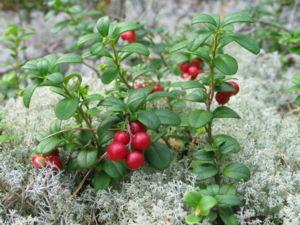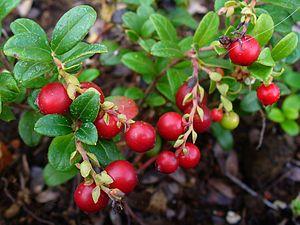
Vaccinium vitis-idaea, photo taken in Sweden. (Photo credit: Wikipedia)
I adore fruit of all kinds, and I am glad to have a small (but growing) collection of blueberry bushes in my garden. Blueberries are rather easy to grow, requiring only a thoughtful pruning in late winter and netting in the summer to fend off the birds and squirrels, but they require strongly acid soil: optimal pH is around 4.8.
This is easy to achieve in my garden, as the pH seems to hover in this general area if it has never been improved. Good drainage, another important component for a successful blueberry crop, I can achieve by digging in chopped oak leaves and decomposed pine bark mulch at planting time.
The challenge, then? Integrating them gracefully into the larger landscape. Blueberries can grow to be fairly large plants–mine are 5 feet tall and wide, varying in shape from a clumsy vase to a clumsy umbrella–and probably five years old, so they may grow a bit larger still. I am reluctant to dedicate the space I would like to these shrubs given that very little will, or should, grow under them.
I have been reading Lee Reich’s intriguing book, Uncommon Fruits for Every Garden (I wish he could have kept the name of its predecessor, Uncommon Fruits Worthy of Attention), and am building an unreasonably long list of plants I hope (intend) to grow on my heavily wooded, half-acre suburban lot. But Reich recommends one fruit that I think may solve my blueberry dilemma: lingonberries (Vaccinium vitis-idaea).
Extremely popular in Scandinavia but not well known elsewhere (at least around here, except perhaps in the gourmet supermarket jam jar or at IKEA), lingonberries are relatives of blueberries and cranberries. They are extremely cold hardy (not an issue for me), but Reich assures me that they can be grown in areas with hot summers if the cultivar is carefully selected and tended with some care.

English: Vaccinium vitis-idaea, Ericaceae, Cowberry, Lingonberry, fruits. Botanical Garden KIT, Karlsruhe, Germany. Deutsch: Vaccinium vitis-idaea, Ericaceae, Preiselbeere, Früchte. Botanischer Garten KIT, Karlsruhe, Deutschland. (Photo credit: Wikipedia)
The plants grow from a few inches high to nearly 2 feet tall, depending on the subspecies. They demand the same conditions as blueberries: acidic soil, moderate water during fruiting, organic mulch, and perhaps some intelligent shading on hot days (like blueberries, they will grow in part shade although fruit best in full sun). They fruit twice a year, including once in late fall or early winter. And they are evergreen: I envision their short, glossy, oval leaves obscuring my mulch neatly all year.
My theory is that perhaps the blueberry canopy will provide some cooling shade in the hottest months of summer, but not so much as to hinder fruiting substantially.
I think I may have hit on something good. I’ll let you know how it goes.
Additional resources:
- Growing Blueberries in the Home Garden (NC Extension)
- Lingonberry: An Attractive Landscape Plant and a Unique Small Fruit (UMass Extension)

